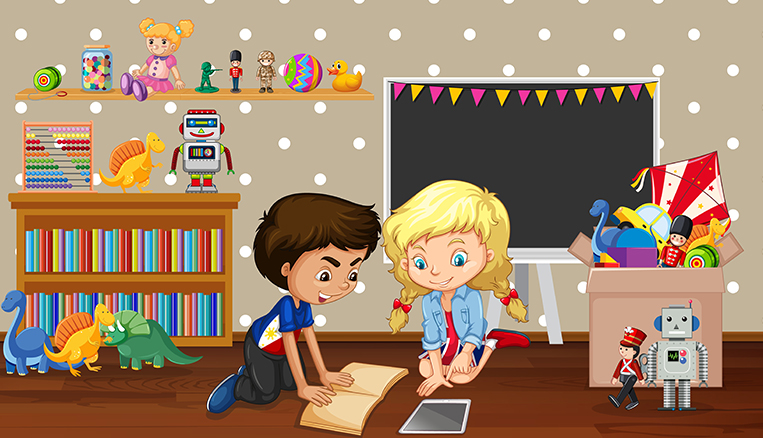
Home Learning Activities For Preschoolers
Times of uncertainty like these disrupt a child’s established schedule, and that can cause little ones anxiety. When it comes to extended stays at home for health and safety, families face a lot of questions from children about why they’re staying home, and challenges with how to keep their child engaged and learning. But times when you rely on each other for support and form stronger bonds as a family can also be rewarding experiences. We’re here to help you keep your kids in the learning mode with educational fun play that makes for great quality time together
Physical development (Gross Motor and Fine Motor)
Play a game of “Real or Make-Believe.”
Place a special toy or small prize on the ground and have your child stand about 20 feet away from the object. Tell them something real or unbelievable about the area around you. If they think what you described is real, they can move three steps closer to the object. If they think it’s make-believe, they stay put. For example, you might say, “There is a pink flower by the fence” or, “I see a blue giraffe under the bush.” Play until they reach their prize.
Role Play and Imagination
Talk to your child about what’s happening in the world. Ask them to play a role of nurse, doctor, and police and ask their reviews about the situation and how they would respond in this situation. Trust me they can come out with the most interesting suggestions and views and it’s natural and healthy for uncertainties over current events to come out in this way.
Language & Literacy
Encourage your child to use their imagination to act out and tell fantastical stories using their favorite toys.
Write down the story they tell and ask them to draw it.
Write uppercase or lowercase letters on paper and cut them apart.
Mix them up in a bowl and imagine you’re making “alphabet soup.” Take turns scooping a letter from the bowl and saying its name and sound. Ready for an extra challenge? Scoop out a letter from the bowl. Without showing it to your child, say “The letter I have makes the __ sound. What’s my letter?”
Write the first few lines of a story your child enjoys on a sheet of paper.
Choose a letter to have them look for and circle with a pencil or crayon. After circling all instances of the letter, have them count how many times the letter appears.
Read a story together and look for one of these sight words on each page: very, an, over, your, and its.
How many instances of each word can you find?
Social and Emotional
Look through children’s books with your child.
Have them tell you if what is happening in the illustrations is real or make-believe.
Go outdoors and look at clouds and puddles.
Use your imaginations and share what you see with each other.
While reading or acting out scenes from favorite stories, talk about how the characters are feeling at different moments in the story.
How do you know the character was feeling a certain way? What did the character do to show how they were feeling?
Memory and Focus
Take turns coming up with sound or action patterns.
For example, repeating the words “trip-trap, trip-trap, trip-trap” is a sound pattern. Clap, stomp, clap, stomp, clap, stomp is an action pattern. If your child seems ready, make the patterns a little more complex by adding a third unique sound or action, or performing one of the sounds or actions more than once in the pattern sequence.
How many huffs and puffs will it take? Gather sticks and twigs, long blades of grass or leaves, and pebbles or stones.
Challenge your child to build a house out of each material, based on the story of “The Three Little Pigs.” After building, have your child predict what will happen when they blow on each one. Observe and talk about the results.
There are plenty of things to measure outdoors!
Grab a ruler, pencil, and paper, and head out to see what you can measure. Have your child draw or write the name of each item they decide to measure, along with the item’s length or height. After measuring a handful of items, compare the data. Which item was the longest or tallest? Shortest?
Creative Expressions
Act out some of your child’s favorite fairy tales or stories.
Gather props from around the house, design a set using some cardboard and art materials, and dress the part. That's half the fun!
Invite your child to design their own “imagination” hat or unicorn horn out of paper, scissors, and tape.
They can decorate their hat or horn using crayons, markers, or whatever craft supplies you have available. When they wear it, they can share their experiences from their imaginative worlds.
Don’t break down that delivery box for recycling just yet!
Give it to your child and challenge them to make the box into something from their imagination. Make crayons, markers, paint, or other craft materials available so they can make their creation come to life.
Gather a variety of natural outdoor materials.
Collect dry grass, leaves, bark, and stones, and work with your child to create a garden where imaginary creatures might live.
